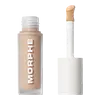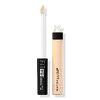What's inside
What's inside
 Key Ingredients
Key Ingredients

 Benefits
Benefits

 Concerns
Concerns

 Ingredients Side-by-side
Ingredients Side-by-side

Water
Skin ConditioningOctyldodecanol
EmollientPropanediol
SolventGlycerin
HumectantDiphenylsiloxy Phenyl Trimethicone
Skin ConditioningCoco-Caprylate/Caprate
EmollientSimmondsia Chinensis Seed Oil
EmollientPolyglyceryl-3 Polyricinoleate
EmulsifyingIsododecane
EmollientAcrylates/Dimethicone Copolymer
Skin ConditioningGlyceryl Caprylate
EmollientSorbitan Isostearate
EmulsifyingDisodium Stearoyl Glutamate
CleansingSodium Chloride
MaskingDisteardimonium Hectorite
StabilisingAluminum Hydroxide
EmollientPolyhydroxystearic Acid
EmulsifyingSodium Hyaluronate
HumectantAlgae Extract
EmollientArnica Montana Flower Extract
MaskingTocopherol
AntioxidantLeuconostoc/Radish Root Ferment Filtrate
AntimicrobialTremella Fuciformis Extract
HumectantPentylene Glycol
Skin Conditioning1,2-Hexanediol
Skin ConditioningFructose
HumectantUrea
BufferingCitric Acid
BufferingSodium Hydroxide
BufferingEthyl Hexanediol
SolventIpomoea Batatas Root Extract
Skin ConditioningHydroxyacetophenone
AntioxidantMaltose
MaskingSodium PCA
HumectantSodium Lactate
BufferingTrehalose
HumectantAllantoin
Skin ConditioningGlucose
HumectantTitanium Dioxide
Cosmetic ColorantCI 77491
Cosmetic ColorantCI 77492
Cosmetic ColorantCI 77499
Cosmetic ColorantWater, Octyldodecanol, Propanediol, Glycerin, Diphenylsiloxy Phenyl Trimethicone, Coco-Caprylate/Caprate, Simmondsia Chinensis Seed Oil, Polyglyceryl-3 Polyricinoleate, Isododecane, Acrylates/Dimethicone Copolymer, Glyceryl Caprylate, Sorbitan Isostearate, Disodium Stearoyl Glutamate, Sodium Chloride, Disteardimonium Hectorite, Aluminum Hydroxide, Polyhydroxystearic Acid, Sodium Hyaluronate, Algae Extract, Arnica Montana Flower Extract, Tocopherol, Leuconostoc/Radish Root Ferment Filtrate, Tremella Fuciformis Extract, Pentylene Glycol, 1,2-Hexanediol, Fructose, Urea, Citric Acid, Sodium Hydroxide, Ethyl Hexanediol, Ipomoea Batatas Root Extract, Hydroxyacetophenone, Maltose, Sodium PCA, Sodium Lactate, Trehalose, Allantoin, Glucose, Titanium Dioxide, CI 77491, CI 77492, CI 77499
Water
Skin ConditioningCyclopentasiloxane
EmollientHydrogenated Polyisobutene
EmollientGlycerin
HumectantSorbitan Isostearate
EmulsifyingPropylene Glycol
HumectantTitanium Dioxide
Cosmetic ColorantOzokerite
Emulsion StabilisingPhenoxyethanol
PreservativeMagnesium Sulfate
Disteardimonium Hectorite
StabilisingDisodium Stearoyl Glutamate
CleansingMethylparaben
PreservativeAcrylates Crosspolymer
AbsorbentAlumina
AbrasiveButylparaben
MaskingAluminum Hydroxide
EmollientTocopherol
AntioxidantSilica
AbrasiveChamomilla Recutita Extract
Skin ConditioningCI 77891
Cosmetic ColorantIron Oxides
Mica
Cosmetic ColorantWater, Cyclopentasiloxane, Hydrogenated Polyisobutene, Glycerin, Sorbitan Isostearate, Propylene Glycol, Titanium Dioxide, Ozokerite, Phenoxyethanol, Magnesium Sulfate, Disteardimonium Hectorite, Disodium Stearoyl Glutamate, Methylparaben, Acrylates Crosspolymer, Alumina, Butylparaben, Aluminum Hydroxide, Tocopherol, Silica, Chamomilla Recutita Extract, CI 77891, Iron Oxides, Mica
 Reviews
Reviews

Ingredients Explained
These ingredients are found in both products.
Ingredients higher up in an ingredient list are typically present in a larger amount.
Aluminum Hydroxide is a form of aluminum. It can be naturally found in nature as the mineral gibbsite. In cosmetics, Aluminum Hydroxide is used as a colorant, pH adjuster, and absorbent.
As a colorant, Aluminum Hydroxide may add opacity, or reduce the transparency. Aluminum hydroxide is contains both basic and acidic properties.
According to manufacturers, this ingredient is an emollient and humectant. This means it helps hydrate the skin.
In medicine, this ingredient is used to help relieve heartburn and help heal ulcers.
There is currently no credible scientific evidence linking aluminum hydroxide in cosmetics to increased cancer risk.
Major health organizations allow the use of aluminum hydroxide in personal care products and have not flagged it as a carcinogenic risk at typical usage levels.
Learn more about Aluminum HydroxideDSG is used as a surfactant.
Surfactants are cleansing ingredients that help remove oil, dirt, and other impurities from the skin. They work by reducing surface tension between water and oils/dirt to allow them to be easily rinsed away.
Disteardimonium Hectorite comes from the clay mineral named hectorite. It is used to add thickness to a product.
It can also help stabilize a product by helping to disperse other ingredients.
Hectorite is a rare, white clay mineral.
Learn more about Disteardimonium HectoriteGlycerin is already naturally found in your skin. It helps moisturize and protect your skin.
A study from 2016 found glycerin to be more effective as a humectant than AHAs and hyaluronic acid.
As a humectant, it helps the skin stay hydrated by pulling moisture to your skin. The low molecular weight of glycerin allows it to pull moisture into the deeper layers of your skin.
Hydrated skin improves your skin barrier; Your skin barrier helps protect against irritants and bacteria.
Glycerin has also been found to have antimicrobial and antiviral properties. Due to these properties, glycerin is often used in wound and burn treatments.
In cosmetics, glycerin is usually derived from plants such as soybean or palm. However, it can also be sourced from animals, such as tallow or animal fat.
This ingredient is organic, colorless, odorless, and non-toxic.
Glycerin is the name for this ingredient in American English. British English uses Glycerol/Glycerine.
Learn more about GlycerinSorbitan Isostearate is an emulsifer and cleaning agent. It is created from isostearic acid and sorbitol.
As an emulsifier, Sorbitan Isostearate prevents oils and water from separating.
Due to its isostearic acid base, it may not be safe for Malassezia or fungal acne.
Learn more about Sorbitan IsostearateTitanium dioxide is a mineral UV filter widely used in sunscreens and cosmetics.
It is one of only two UV filters officially classified as “mineral” by regulatory agencies, the other being zinc oxide.
Titanium dioxide provides broad-spectrum protection mostly in the UVB and UVAII range, with some protection in the UVAI range.
While its UVA protection isn’t as strong as zinc oxide’s, the difference is minor.
A common myth is that mineral UV filters reflect UV light. However, modern research shows titanium dioxide absorbs UV radiation like chemical filters (~95% absorption & 5% reflection).
Thanks to its non-irritating nature, titanium dioxide is suitable for sensitive, acne-prone, or redness-prone skin. It is unlikely to cause "eye sting" like other sunscreen ingredients.
A major drawback of this ingredient is its white cast and thick texture. This is why mineral sunscreens often leave a white cast and are less cosmetically elegant than chemical/hybrid sunscreens.
To improve white cast and spreadability, micronized or nano-sized titanium dioxide is often used.
There are ongoing concerns surrounding nano-titanium oxide's impact on marine ecosystems.
There is no conclusive evidence that any form of titanium oxide (or any other sunscreen ingredients) will cause harm to marine ecosystems or coral reefs. The science is still developing but many consumers are keeping a close eye on this issue.
Please note, many destinations have reef-safety sunscreen rules. For instance, the U.S. Virgin Islands advises all visitors to use non-nano mineral sunscreens.
Nano mineral sunscreens once raised safety concerns about absorption into skin.
Extensive research has shown that they do not penetrate healthy or damaged skin; they remain safely on the surface and the top layer of dead skin (stratum corneum).
You'll likely find titanium dioxide bundled with alumina, silica, or dimethicone. These ingredients help make titanium dioxide highly photostable; this prevents it from interacting with other formula components under UV light.
Learn more about Titanium DioxideTocopherol (also known as Vitamin E) is a common antioxidant used to help protect the skin from free-radicals and strengthen the skin barrier. It's also fat soluble - this means our skin is great at absorbing it.
Vitamin E also helps keep your natural skin lipids healthy. Your lipid skin barrier naturally consists of lipids, ceramides, and fatty acids. Vitamin E offers extra protection for your skin’s lipid barrier, keeping your skin healthy and nourished.
Another benefit is a bit of UV protection. Vitamin E helps reduce the damage caused by UVB rays. (It should not replace your sunscreen). Combining it with Vitamin C can decrease sunburned cells and hyperpigmentation after UV exposure.
You might have noticed Vitamin E + C often paired together. This is because it is great at stabilizing Vitamin C. Using the two together helps increase the effectiveness of both ingredients.
There are often claims that Vitamin E can reduce/prevent scarring, but these claims haven't been confirmed by scientific research.
Learn more about TocopherolWater. It's the most common cosmetic ingredient of all. You'll usually see it at the top of ingredient lists, meaning that it makes up the largest part of the product.
So why is it so popular? Water most often acts as a solvent - this means that it helps dissolve other ingredients into the formulation.
You'll also recognize water as that liquid we all need to stay alive. If you see this, drink a glass of water. Stay hydrated!
Learn more about Water